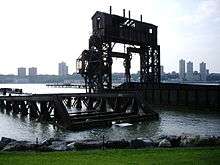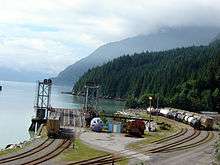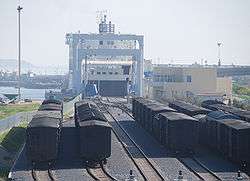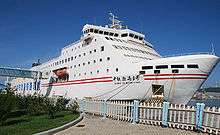Train ferry
A train ferry is a ship (ferry) designed to carry railway vehicles. Typically, one level of the ship is fitted with railway tracks, and the vessel has a door at the front and/or rear to give access to the wharves. In the United States, train ferries are sometimes referred to as "car ferries", as distinguished from "auto ferries" used to transport automobiles. The wharf (sometimes called a "slip") has a ramp, and a linkspan or "apron", balanced by weights, that connects the railway proper to the ship, allowing for the water level to rise and fall with the tides.
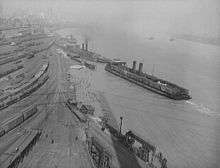
While railway vehicles can be and are shipped on the decks or in the holds of ordinary ships, purpose-built train ferries can be quickly loaded and unloaded by roll-on/roll-off, especially as several vehicles can be loaded or unloaded at once. A train ferry that is a barge is called a car float or rail barge.
History

An early train ferry was established as early as 1833 by the Monkland and Kirkintilloch Railway. To extend the line over the Forth and Clyde Canal in Scotland, the company began operating a wagon ferry to transport the rolling stock over the canal.[1][2] In April 1836, the first railroad car ferry in the U.S., Susquehanna, entered service on the Susquehanna River between Havre de Grace and Perryville, Maryland.[2]
The first modern train ferry was Leviathan, built in 1849. The Edinburgh, Leith and Newhaven Railway was formed in 1842 and the company wished to extend the East Coast Main Line further north to Dundee and Aberdeen. As bridge technology was not yet capable enough to provide adequate support for the crossing over the Firth of Forth, which was roughly five miles across, a different solution had to be found, primarily for the transport of goods, where efficiency was key.
The company hired the up-and-coming civil engineer Thomas Bouch who argued for a train ferry with an efficient roll-on roll-off mechanism to maximise the efficiency of the system. Custom-built ferries were to be built, with railway lines and matching harbour facilities at both ends to allow the rolling stock to easily drive on and off the boat.[3] To compensate for the changing tides, adjustable ramps were positioned at the harbours and the gantry structure height was varied by moving it along the slipway. The wagons were loaded on and off with the use of stationary steam engines.[3][2]
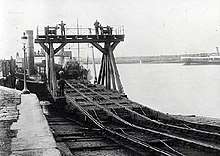
Although others had had similar ideas, it was Bouch who first put them into effect, and did so with an attention to detail (such as design of the ferry slip). This led a subsequent President of the Institution of Civil Engineers[4] to settle any dispute over priority of invention with the observation that "there was little merit in a simple conception of this kind, compared with a work practically carried out in all its details, and brought to perfection."[5]
The company was persuaded to install this train ferry service for the transportation of goods wagons across the Firth of Forth from Burntisland in Fife to Granton. The ferry itself was built by Thomas Grainger, a partner of the firm Grainger and Miller.[6]
The service commenced on 3 February 1850.[7] It was called "The Floating Railway" [8] and intended as a temporary measure until the railway could build a bridge, but this was not opened until 1890, its construction delayed in part by repercussions from the catastrophic failure of Thomas Bouch's Tay Rail Bridge.[9]
The largest train ferry ever built is MS Skåne on the Trelleborg-Rostock route, built in 1998, 200 meters (660 ft) long, 29 meters (95 ft) wide, with six tracks plus two on an elevator to the lower deck, having a total length of track of 1,110 meters (3,640 ft).
Hazards
Train ferries rarely sink because of sea hazards, although they have some weaknesses linked to the very nature of transporting trains "on rail" on a ship.
These weaknesses include:
- Trains are loaded at a rather high level, making the ship top-heavy.
- The train deck is difficult to compartmentalise, so that sloshing flood water can destabilise the ship.
- The sea doors where the trains go in and out are a weakness, even if placed at the rear of the ship.
- The train carriages need to be strongly secured lest they break away and roll around, particularly on long, open-water routes.
The Ann Arbor Railroad of Michigan developed a system of making cars secure that was adopted by many other lines. Screw jacks were placed on the corners of the railcar and the car was raised slightly to take its weight off of its wheels. Chains and turnbuckles were placed around the car frame and hooked onto the rails and tightened. Clamps were placed behind the wheels on the rails. Deckhands engaged in continual inspection and tightening of the gear during the crossing. This system effectively held the cars in place when the ship encountered rough weather.
Some accidents have occurred at the slip during loading, when stability can be a major problem. Train ferries often list when heavy cars are loaded onto a track on one side while the other side is empty. Normal procedure was to load half of a track on one side, all of the track on the other side, and then the rest of the original track. If this procedure was not followed, results could be disastrous. In 1909, SS Ann Arbor No. 4 capsized in its slip in Manistique, Michigan when a switching crew put eight cars of iron ore on its portside tracks. The crew got off without loss of life, but salvage operations were costly and time-consuming.
The Japanese train ferry, Toya Maru, sank during typhoon Marie on 26 September 1954, killing more than a thousand. Four other train ferries, Seikan maru No.11, Kitami Maru, Tokachi Maru and Hidaka Maru also sank on that day; the loss appeared to be of about 1,430 people.
At the time, Japanese train ferries did not have a rear sea-gate, because engineers believed that in-rushing water would simply flow out again quickly and would not pose a danger. However, when the frequency of waves bears the wrong relationship to the length of a ship, each wave arrives as the water from the previous wave is trying to leave, causing water to accumulate on the ship. After the accidents, all Japanese train ferries were retrofitted with rear sea-gates and weather forecast technology was greatly promoted.
The Norwegian train ferry, Skagerrak, built in 1965, sank in gale-force winds on 7 September 1966, on a journey between Kristiansand, Norway, and Hirtshals, Denmark, when the rear sea-gate was destroyed by heavy seas. One person subsequently died of injuries, and six freight cars and a number of automobiles sank to the bottom with the ship.

The Canadian train ferry MV Patrick Morris sank on 20 April 1970, while assisting in a search and rescue operation for a sinking fishing trawler (MFV Enterprise) off the northeast coast of Cape Breton Island. The ferry was trying to maintain position to retrieve a body when its stern gates were overpowered by 30-foot (9 m) waves. It sank within 30 minutes taking several rail cars and 4 crew members, including the Captain, to the bottom of the Cabot Strait. There were 47 survivors.
Several train ferries, including SS Milwaukee, SS Pere Marquette 18, and SS Marquette & Bessemer No. 2, have been lost on the Great Lakes. These losses, though causes remain unconfirmed, were attributed to seas boarding the unprotected stern of the ship and swamping it in a severe storm. As a result, seagates were required on all new ships and required to be retrofitted on older vessels. In addition, two wooden cross-lake railroad ferries caught fire and burned.
Examples
Argentina
Nine train ferries were used between 1907 and 1990 to cross the Paraná river and join the Buenos Aires province (the main state in Argentina) and the Entre Rios province (the entrance to the Mesopotamian region), until new bridges were built over the rivers they crossed. They were Lucía Carbó (1907), María Parera (1908), Mercedes Lacroze (1909) (three ferries that operated between the ports of Zárate and Ibicuy (Entre Rios), crossing the Paraná River at the northwest of the Buenos Aires province). Then were added Roque Saenz Peña (1911) and Ezequiel Ramos Mejía (1913), paddle train ferries, at Posadas (crossing the Paraná River in the southwest of the Misiones province, at the north of the country, in the frontier with Paraguay).
Three other train ferries were added later: Dolores de Urquiza (1926), Delfina Mitre (1928) and Carmen Avellaneda (1929) to cover the service in the Zárate-Ibicuy crossing. María Parera had a collision with Lucía Carbó at km. 145 of the Paraná River, and it sank in less than 15 minutes on June 30, 1926. Two of the most modern still serve as floating piers in the Zárate region, and one of the first group was sunk during a storm at the Buenos Aires port in the 1980s. The two northern paddle ferries still remain at Posadas, and one of them holds a model railway museum inside. All the eight old ferries were built by the A & J Inglis Co. Ltd., in Pointhouse, Glasgow, Scotland, for the Entre Rios Railways Co. in Argentina. The ninth ferry, Tabare, was built in Argentina by Astarsa (ASTilleros ARgentinos S.A.) in 1966 at Astillero Río Santiago Río Santiago Shipyard near to La Plata city. It was the largest train ferry that operated in Argentina, with a deck more than 100 meters long. Tabaré is still floating, but not operating, at the old south docks of Buenos Aires port, near the Puerto Madero zone.
Australia
- Grafton, New South Wales, over Clarence River pending construction of bridge, 1920s to 1930s.
Azerbaijan
- Baku – Türkmenbaşy (Russian: Krasnovodsk) (Паромная переправа Баку — Туркменбаши), connecting Azerbaijan with Turkmenistan across the Caspian Sea since 1963. In May 2008 they decided to buy a longer ferry.[10]
Bangladesh
- from Balashi Ghat to Bahadurabad Ghat – 1,000 mm (3 ft 3 3⁄8 in) gauge.
- across the Brahmaputra River in Bangladesh – superseded by Jamuna Bridge, 2003; 1,676 mm (5 ft 6 in) and 1,000 mm (3 ft 3 3⁄8 in) dual gauge.
Belgium
- Former link from Zeebrugge to Harwich, United Kingdom – ceased in 1987.
Bolivia
- Train ferry from Peru – 1,435 mm (4 ft 8 1⁄2 in) and 1,000 mm (3 ft 3 3⁄8 in) gauges at each end.
Bulgaria
- The Varna-Odessa (Ukraine) train ferry line served by 4 boats (13,000 tonnes deadweight (DWT) each, carrying 108 loaded railroad cars) opened in 1978, bypasses a break of gauge. Later, the service was extended to include lines to Poti and Batumi, Georgia. Boats can carry trucks and passengers as well.
Canada
A railbarge is a variation of a train ferry that consists of barges pushed by a tug.
In use
- Prince Rupert, British Columbia – Whittier, Alaska (Aquatrain)
- Delta, British Columbia – Nanaimo, British Columbia (E and N Railway)
- Matane, Quebec – Baie-Comeau, Quebec (COGEMA)[11]
Former car floats
- lakes of British Columbia Okanagan, Arrow, Kootenay lakes (CN and CPR)
- Port Maitland, Ontario – Ashtabula, Ohio (TH&B Navigation Company)
- Port Burwell, Ontario – Ashtabula, Ohio (CN)
- Cobourg, Ontario – Rochester, New York (Ontario Car Company) ran from 1905 to 1950
- Sarnia, Ontario – Port Huron, Michigan – rail-barge – (CN, until the opening of the Paul Tellier Tunnel)
- Windsor, Ontario – Detroit, Michigan (Grand Trunk, CN, CPR, Michigan Central, Wabash, until the 1980s)
- BC Rail. until 1952 railcars were barged from North Vancouver to Squamish.
- A large number of isolated BC pulp mills had chemicals and freight moved by railbarge.
Former train ferries
- Cape Tormentine, New Brunswick – Borden-Carleton, Prince Edward Island (Canadian Government Railways, CN, CN Marine, Marine Atlantic), using MV Abegweit and MV John Hamilton Gray. Service ended when rail service on Prince Edward Island was discontinued in 1989. See Prince Edward Island Railway for more information.)
- Mulgrave, Nova Scotia – Point Tupper, Nova Scotia (Intercolonial, CN, until the opening of the Canso Causeway in 1955)
- North Sydney, Nova Scotia – Port aux Basques, Newfoundland (CN, CN Marine). Service commenced in 1965 carrying standard-gauge rolling stock. A dual-gauge yard in Port aux Basques was used for classification and rolling stock had trucks exchanged with narrow gauge trucks. Service ended when the Newfoundland section of Canadian National Railway was closed in 1988. See Newfoundland Railway for more information.)
- Lake Superior, Thunder Bay – Superior, Wisconsin.
- Sarnia, Canada – Port Huron, Michigan, United States – replaced by tunnel under St. Clair River c. 1891.[12]
In use
- Guangdong–Hainan Railway: Part of this railway is the Yuehai (粤海, i.e. Guangdong-Hainan) Ferry which crosses the Qiongzhou Strait, between Zhanjiang, Guangdong and Haikou, Hainan. The line has operated since January 2003, carrying both freight and passenger trains, enabling direct train service between the mainland and the cities of Haikou and Sanya on Hainan Island.[13] As of the late 2010, two ferry boats were in operation; the third boat, Yuehai No. 3, was launched in Tianjin in September 2010, and was going to be delivered to the ferry company in December 2010.[14]
- Bohai Train Ferry: Yantai in Shandong Province to Dalian in Liaoning Province. This short-cut line, operated by Sinorail, has been running since November 2006. As of 2020, it only carry freight trains, but passengers can also be on board the ship.[15]
Former
- Yangtze River in Wuhan before construction of the Wuhan Yangtze River Bridge. Hunslet Engine Company built two extra heavy 0-8-0 locomotives for loading the train ferries.
- Yangtze River in Nanjing on Jinghu railway, 1933–1968.
- Huangpu River in Minhang on Wujing–Zhoujiadu Railway
- Yangtze River in Wuhu on Huainan railway, before 2000.
- Jiangyin Train Ferry on the Xinyi–Changxing Railway (freight only). Trains are carried from Jingjiang on the northern side of the Yangtze River (terminal at 31°58′33″N 120°18′27″E) to Jiangyin on the southern side (terminal at 31°57′16″N 120°19′25″E). A pair of ferries make 48 trips per day across the river.[16] The service ended on 16 December 2019.[17]
Cuba
Note: all auto and rail ferry services have been suspended between the United States and Cuba due to the ongoing United States embargo against Cuba.
- Palm Beach – Havana, Cuba.
- Miami – Havana, Cuba
- New Orleans – Havana, Cuba
- New York – Havana – Seatrain Lines
Denmark
Former
- Rødby – Puttgarden, Germany across Fehmarn Belt. 1963–2019, Vogelfluglinie. To be replaced by Fehmarn Belt Fixed Link in 2028. Not used by freight trains since 1997; they go over the Great Belt Bridge instead. Night trains used the ferry until 1997.[18]
- Strib – Fredericia, 1872–1935, replaced by Little Belt Bridge
- Korsør – Nyborg (see Great Belt ferries), 1883–1997, replaced by Great Belt fixed link
- Oddesund Syd – Oddesund Nord, 1883–1938, replaced by Oddesund Bridge
- Masnedø – Orehoved, 1884–1937, replaced by Storstrøm Bridge
- Glyngøre – Nykøbing Mors, 1889–1977
- Helsingør – Helsingborg, Sweden, 1892–2000, since then car ferry only
- Copenhagen Frihavn – Malmö, Sweden, 1895–1986
- Gedser – Warnemünde, Germany, 1903–1995, replaced by car ferry Gedser – Rostock, Germany
- Faaborg – Mommark, 1922–1962, freight only
- Assens – Aarøsund, 1923–1950, freight only, narrow gauge (1,000 mm (3 ft 3 3⁄8 in))
- Svendborg – Rudkøbing, 1926–1962, freight only
- Hvalpsund – Sundsøre, 1927–1969, since then car ferry only
- Svendborg – Ærøskøbing, 1931–1994, freight only
- Gedser – Großenbrode Kai, Germany, 1951–1963, replaced by Rødby — Puttgarden Ferry
- Hirtshals – Kristiansand, Norway, 1958–1996, freight only
- Copenhagen Frihavn – Helsingborg, Sweden (Danlink) 1986–2000, freight only
- Frederikshavn – Gothenburg, Sweden, 1987–2015, freight only[19]
Finland
Former
- Stockholm – Naantali (1967–75), normal gauge on board, break-of-gauge in Naantali, freight only
- Travemünde – Hanko (1975–98), normal gauge on board, break-of-gauge in Hanko, freight only
- Travemünde – Turku (1998–2007), normal gauge on board, break-of-gauge in Turku, freight only
- Hargshamn (Sweden) – Uusikaupunki (1989–96), normal gauge on board, break-of-gauge in Uusikaupunki, freight only
- Turku – Stockholm (-2012, see SeaRail), normal gauge on board, break-of-gauge in Turku, freight only
France
- Calais and Dunkirk from Richborough, United Kingdom, between 1918 and 1919 transporting war material to the Front
- Dieppe from Southampton, United Kingdom between 1918 and 1919 transporting war material to the Front
- Dunkerque to Dover, United Kingdom – ceased in 1995 due to the opening of the Channel Tunnel.
Germany
Former
- Constance (Bodensee) (1869–1976)
- Grossenbrode – Fehmarnsund (1903–1963)
- Grossenbrode – Gedser (1951–1963)
- Elbe: Lauenburg–Hohnstorf (1864–1878)
- Elbe: Köhlbrand, Hamburg (1912–1974)
- Mukran – Klaipėda, Lithuania, break of gauge, 1,520 mm (4 ft 11 27⁄32 in) broad gauge on board, freight only (1986–2013)
- Mukran (changed in 1988 from the old Sassnitz port to the new port nearby at Mukran) – Trelleborg, Sweden, freight plus one daily passenger night-train. (1909–2014[20])
- Mukran – Ust-Luga, Russia, break of gauge, 1,520 mm (4 ft 11 27⁄32 in) broad gauge on board, freight only (2012–2016[21])
- Puttgarden – Rødby, Denmark (1963–2019) Not used by night and freight trains since 1997 (they go over the Great Belt Bridge instead). To be replaced by Fehmarn Belt Fixed Link in 2028.
- Rhine: Worms–Rosengarten (1870–1900)
- Rhine: Bingerbrück–Rüdesheim (1861–1900)
- Rhine: Bonn–Oberkassel (1870–1914)
- Rhine: Rheinhausen–Hochfeld (1866–1874)
- Rhine: Ruhrort–Homberg (1852–1912)
- Rhine: Spyck–Welle (1865–1912)
- Stralsund – Altefähr/Rügen replaced 1936 by the Rügendamm.
- Rostock – Trelleborg, Sweden (1994–2014)
- Travemünde – Hanko (1975–1998), 1,435 mm (4 ft 8 1⁄2 in) standard gauge on board, break of gauge in Hanko, freight only
- Travemünde – Turku (1998–2007), 1,435 mm (4 ft 8 1⁄2 in) on board, break of gauge in Turku, freight only
- Travemünde – Malmö
- Warnemünde – Gedser (1903–1995), replaced by car ferry Rostock – Gedser
- Wittow Fähre – Fährhof 1896–1968, operated by the Rügen Light Railway (750 mm (2 ft 5 1⁄2 in)).
- Wolgast – Wolgaster Fähre (Usedom), 1945−1990 (only freight)
Georgia
- Russia to Georgia, bypasses Abkhazia.
Iran
A new train ferry link-span terminal is under construction at Amirabad Special Economic Zone, Mazandaran Province, Iran.
Iraq
Train ferries were at one time used to cross the Euphrates River at Baghdad.
Italy
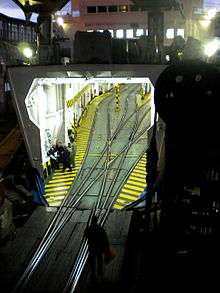
- In use
- Calabria-Sicily and vice versa: between the ports of Villa San Giovanni in the Region of Calabria and Messina in the Region of Sicily — passenger and freight service.
- Former
- Mainland to Sardinia: between the ports of Civitavecchia and Golfo Aranci – freight service stopped in 2009.
- Mainland to station and the factory in the city : between the station of Venezia Santa Lucia and the city – freight service only by barge.
- Paratico-Sarnico to Lovere on Lake Iseo, see it:Ferrovia Palazzolo-Paratico
Both Sicily and Sardinia services are operated by Bluvia that is a subsidiary company of Rete Ferroviaria Italiana. At present the link between Mainland and Sicily has a regular and frequent activity, while the link between Mainland and Sardinia is less frequent and operated basically day by day on the basis of the actual traffic demand.
Japan
In Japanese, a train ferry is called "鉄道連絡船 tetsudō renrakusen", which means literally "railway connection ship". Such ships may or may not be able to carry railcars. A ferry service that is part of a railway schedule and its fare system is called "tetsudō renrakusen".
Japan Railways linked the four main Japanese islands with train ferries before these were replaced by bridges and tunnels.
There were three ferry services that carried trains. Through operations of passenger trains using train ferries were conducted between December 1948 and 11 May 1955. The passenger services was canceled after the disasters of Toya Maru (26 September 1954, killed 1,153) and the Shiun Maru (11 May 1955, killed 168) occurred, after which the Japanese National Railways (JNR) considered it dangerous to allow passengers to stay on trains aboard ship. These three lines have been replaced by tunnels and bridges.
- Seikan Ferry
- The Seikan ferry connected Aomori Station and Hakodate Station crossing the Tsugaru Strait connecting Honshū and Hokkaidō. The first full-scale train ferry, Shōhō Maru, entered service in April, 1924. On 13 March 1988, the Seikan Tunnel was opened and the ferry ceased operation. The tunnel and the ferry line was operated simultaneously only on that day.
- Ukō Ferry
- The Ukō ferry connected Uno station and Takamatsu station crossing the Seto Inland Sea connecting Honshū and Shikoku. The ferry service started carrying railcars on 10 October 1921. On 9 April 1988, the Great Seto Bridge was opened and the last train ferry operated on the previous day.
- Kammon Ferry
- The Kammon ferry connected Shimonoseki Station and Mojikō Station crossing the Kanmon Strait connecting Honshū and Kyūshū. This was the first train ferry service in Japan starting operation on 1 October 1911. The train ferries used piers at Komorie station. After the completion of the Kanmon Tunnel on 1 July 1942, the service was discontinued and the ferries were transferred to the Ukō Ferry operation.
Lithuania
- Klaipėda, 1,520 mm (4 ft 11 27⁄32 in) – Mukran, Germany, 1,435 mm (4 ft 8 1⁄2 in) (1986-). Freight only. Bogie exchanges take place in Mukran.
Mexico
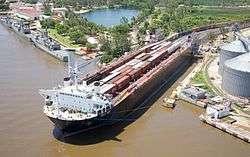
- CG Railway, connecting the Port of Mobile, Alabama, USA and Coatzacoalcos, Veracruz, Mexico. It is served by the BNSF Railway, Canadian National Railway, CSX Transportation, Kansas City Southern Railway, and the Norfolk Southern Railway.[22]
The Netherlands
From 1886 to 1936, train ferries sailed between Stavoren and Enkhuizen across the IJsselmeer. From 1914 to 1983 a ferry carried freight carriages from the Rietlanden shunting area to the Amsterdam-Noord railway network, which was not connected over land to the rest of the Dutch railway network.
New Zealand
- The Interislander runs a train ferry (called rail ferries locally), Aratere, across Cook Strait between Wellington and Picton, carrying both road and rail cargo on separate decks. Kaitaki and Kaiarahi also serve this route, but carry road vehicles only.
Nigeria
- A temporary ferry was used at the crossing of the Niger River due to delays finding foundations for a bridge.[23]
- similarly at Makurdi on the River Benue, replaced by a road-rail bridge in 1932.
Norway
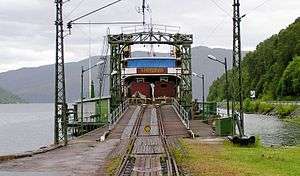
- Historically the lake Tinnsjø railway ferry (1909–1991) linked the Tinnoset Line and Rjukan Line, transporting goods to and from Rjukan and the Norsk Hydro heavy water factory, as seen in the film The Heroes of Telemark, starring Kirk Douglas.
- Hirtshals, Denmark–Kristiansand, Norway, 1958–1996, freight only
Peru
- Link with Bolivia across Lake Titicaca. The car float Manco Capac has dual gauge tracks for both Peruvian 1,435 mm (4 ft 8 1⁄2 in) standard gauge and Bolivian 1,000 mm (3 ft 3 3⁄8 in) meter gauge. There are small stretches of dual gauge trackage at Puno in Peru and Guaqui in Bolivia. Car loading and unloading are done at docks. The British-built steamship Ollanta is no longer maintained, but PeruRail, in charge of the vessel, is trying to develop a tourist project soon.[25]
Russia & former USSR
Black Sea
- Kerch Strait ferry line from Port Kavkaz to Port Krym, across the Kerch Strait. Operated from 1953 to 1993. In 2004, service restored as a car ferry so far; possibility of carrying rail cars is studied as well.[26]
- Varna-Illichivsk[27]
Pacific Ocean
- Vanino - Kholmsk, connecting Sakhalin Island with the mainland. (Since 1973). The ferry line is operated by the Sakhalin Shipping Company. Since Sakhalin railways use the Japanese gauge of 1,067 mm (3 ft 6 in), the railcars coming from the Russian mainland need their bogies changed; this is done in Kholmsk.[28]
Caspian Sea
The Caspian Shipping Company (Caspar) has 7 train ferries and is building two more.
See Iran.
Baltic Sea
- Baltijsk to Ust-Luga
Former
- SS Baikal was a train ferry which operated on Lake Baikal in the early 1900s between Port Baikal and Mysovaya, filling a gap in the Transsiberian Railway before the completion of the Circum-Baikal Railway around the lake.
- Baltijsk to Sassnitz-Mukran (Germany) (2008[30]–2016[31])
- Ust-Luga to Sassnitz-Mukran (Germany) (2012–2016)
Sudan
A ferry, though not necessarily a train ferry, links the 1,435 mm (4 ft 8 1⁄2 in) gauge network of Egypt and the 1,067 mm (3 ft 6 in) network of Sudan, across the Nile River.
Sweden
In use
- Ystad – Świnoujście, Poland (1974-), freight only
- Trelleborg – Saßnitz, Germany, both freight and passenger trains
Former
- Gothenburg – Frederikshavn, Denmark (1987–2015)
- Helsingør, Denmark – Helsingborg (1892–2000)
- Copenhagen, Denmark – Helsingborg (1986–2000), freight only
- Copenhagen, Denmark – Malmö (1895–1986)
- Trelleborg – Gdansk, Poland (1946)
- Trelleborg – Gdynia, Poland (1947–1950)
- Trelleborg – Rostock, Germany (1996–2014), freight only
- Trelleborg – Sassnitz (Mukran port), Germany, (1998–2014) operated by Stena Line
- Trelleborg – Świnoujście, Poland (1948–1953), was supposed to replace the Ystad – Świnoujście service in 2010 again, but that didn't happen
- Trelleborg – Warnemünde, the GDR (1948–1953)
- Bergkvara – Mörbylånga, normal gauge 1,435 mm (4 ft 8 1⁄2 in) between 1,067 mm (3 ft 6 in) in Bergkvara and 891 mm in Mörbylånga (1953–1955)
- Kalmar – Färjestaden, narrow gauge 891 mm (1957–1962)
- Stockholm – Naantali, Finland (1967–1975), normal gauge on board, break-of-gauge in Naantali, freight only
- Malmö – Travemünde, Germany (from the mid-1980s until a few years after 2000)
- Hargshamn (Sweden) – Uusikaupunki (1989–96), normal gauge on board, break-of-gauge in Uusikaupunki, freight only
- Stockholm – Turku, Finland (SeaRail, ended 2012, normal gauge 1,435 mm (4 ft 8 1⁄2 in))
Never opened
- Trelleborg – Travemünde, the ferries were built (Nils Dacke and Robin Hood 1988-89) but the service never opened, as the "Iron Curtain" fell. The ferries were supposed to offer an alternative, which was not going through East Germany, to the ferries from Rostock and Sassnitz, which were in East Germany. With reunification that aim became obsolete.
Tanzania
See Uganda.
Turkey
- Bosphorus: Train ferries used to connect the European railway network with main connections from Thessaloniki, Greece, and Bucharest, Romania terminating at the Sirkeci Terminal to the Asian network terminating at the Haydarpaşa Terminal. Closure of lines within Istanbul in both sides due to Marmaray project caused these ferry services to become useless since the beginning of 2012. Ferry service between Tekirdağ and Derince replaced this ferry service which started at the end of 2013.[32] The current Marmaray Tunnel project, originally to be completed in 2015, will replace partially the ferry connection with an underwater railway tunnel running between the two sides.
- Black Sea: Chornomorsk, Ukraine to Derince, Turkey, bypasses a break of gauge
- Black Sea:- Samsun, Turkey to Kavkaz, Russia: Launched in December 2010[33]
- Lake Van – Tatvan — Van. The Istanbul — Tehran "Trans-Asya-Ekspresi" operates and the Damascus–Tehran passenger train operated from each terminus to the ferry ports. Only the luggage van takes the ferry due to capacity restrictions, the passengers have to change at both ends. The Lake Van ferry is part of the planned Trans-Asian Railway, Istanbul — Singapore. A scheduled freight train runs from Istanbul to Kazakhstan. The train ferry was established to avoid an expensive railroad line along the mountainous southern shore and may be replaced when traffic increases sufficiently; there are reports of financing discussions between the governments of Turkey and Iran. The ferry route is 96 km (60 mi) long while a rail alternative on the north side would be 250 km (160 mi) long in mountainous terrain. There are four ferries each of 16 coach capacity capable of making three trips per day.[34] Other sources describe the ferries' capacity as 450 tons (9 to 14 railcars).[35]

- Tekirdağ-Derince Ferry: The ferry service had started at the end of 2013 connecting Europe to Asia by rail.[32] The service is given by TCDD where a maritime company is the subcontractor. The ferry is MF Erdeniz, which used to carry wagons between Eregli and Zonguldak ports. She is now carrying wagons between Tekirdağ Port and Derince Port, İzmit. Ferry has 5 lines which are in total, 800 meters (2,600 ft) long. It can travel between Tekirdağ and Derince in 8 hours.
- Tekirdağ-Bandırma Ferry: TCDD is constructing another ferry ramp at Bandırma Port and is planning to give ferry service between Tekirdağ and Bandırma ports. This service will connect Agean Region of Turkey to Europe by rail.
Uganda
- A train ferry on Lake Victoria links the 1,000 mm (3 ft 3 3⁄8 in) gauge network of the Uganda Railway at Port Bell with the 1,000 mm gauge network of Tanzania at Mwanza. In June 2008, the Ugandan budget allocated $US8.5m for an additional train ferry for Lake Victoria to replace one that sank after a collision.[36]
Ukraine
- See Bulgaria, Russia and Turkey entries
United Kingdom
Former
- Richborough to Calais and Dunkirk between 1918 and 1919 transporting war material to the Front
- Southampton to Dieppe between 1918 and 1919 transporting war material to the Front
- Harwich to Zeebrugge, Belgium – ceased in 1987.
- Dover - Dunkerque, France – ceased in 1995 due to the opening of the Channel Tunnel.[37] The last Night Ferry passenger train ran on 31 October 1980.[38]
- Langston to Bembridge. A short-lived route of the 1880s operated by the London, Brighton and South Coast Railway, using the former Tay ferry Carrier to link with the Isle of Wight Railway.[39][40]
- The Firths of Tay and Forth in Scotland were crossed by train ferries (Tayport–Broughty Ferry and Granton–Burntisland) until their replacement by bridges.[41]
United States
For international Great Lakes ferries, see Canada.
In use
- New York New Jersey Rail in New York City moves freight cars between Jersey City and Brooklyn. This car float operation provides a southern freight rail gateway to Brooklyn, Queens, and Long Island by avoiding the Selkirk Hurdle. The railroad carries a wide range of goods, including construction materials, food, and consumer products.[42]
- The Alaska Railroad is connected to the rest of the North American rail system only via train ferries. The Alaska Railroad runs its own ferries from Whittier, Alaska to Seattle, while the Canadian National Railway operates its AquaTrain between Whittier and Prince Rupert, British Columbia.
- Central Gulf Railroad, connecting the Port of Mobile, Alabama and Coatzacoalcos, Veracruz, Mexico. It is served by the BNSF Railway, Canadian National Railway, CSX Transportation, Kansas City Southern Railway, and the Norfolk Southern Railway.[22]
Former
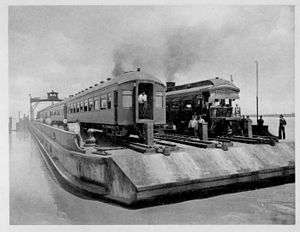
- Brooklyn Eastern District Terminal used car floats.
- Chesapeake Bay – New York, Philadelphia and Norfolk Railroad Ferry from Norfolk to Cape Charles, Virginia, to the early 1940s.[43]
- Chesapeake Bay – Virginia Ferry Corporation from Little Creek, Virginia to Cape Charles, Virginia.[44]
- Chesapeake Bay – Bay Coast Railroad from Norfolk to Cape Charles, Virginia. The shortline railroad had two ferries (25 & 15 cars each) that crossed the Chesapeake Bay about twice a week.
- Lake Michigan – Frankfort, Michigan, to Manitowoc, Kewaunee, Marinette, Wisconsin, or Manistique, Michigan, was the Ann Arbor Railroad's Lake Michigan car ferry service that discontinued in the 1980s. Ann Arbor operated Viking and Arthur K. Atkinson as the final ships on the fleet.
- Lake Michigan – Ludington, Michigan to Manitowoc, Kewaunee or Milwaukee, Wisconsin served by the Pere Marquette Railway and successor Chesapeake and Ohio or Chessie System with the ships SS City of Midland 41 of 1940, SS Spartan and SS Badger, both built in 1953. Badger is now used as an automobile ferry between Manitowoc, Wisconsin, and Ludington, Michigan and represents one of the last large coal-burning passenger-carrying steamers in the world.
- Lake Michigan – Milwaukee, Wisconsin, to Muskegon or Grand Haven, Michigan, was the Lake Michigan car ferry service of the Grand Trunk Western Railroad which was run by its subsidiary company Grand Trunk Milwaukee Car Ferry Company. Its fleet included five ships including SS City of Milwaukee, built in 1931.[45]
- Straits of Mackinac: – Mackinaw City, Michigan, to St. Ignace, Michigan, performed by SS Chief Wawatam[46] at the Straits of Mackinac connecting Michigan's Upper and Lower Peninsulas.
- San Francisco Bay – The San Francisco Belt Railroad had slip at Pier 43 which allowed interchange with the Northwestern Pacific, the Western Pacific, and the Atchison, Topeka and Santa Fe railroads.
- Carquinez Strait – The Central Pacific Railroad operated two train ferries (later assumed by its affiliate the Southern Pacific) between Benicia and Port Costa, California from 1879 to 1930. Solano and Contra Costa were the largest train ferries ever built.
- Pittsburg, California San Francisco–Sacramento Railroad Sacramento_Northern_Railway – the trolley-wire-powered "South End" operated from Sacramento south through farmland, marshes, over river by its own ferry, to Pittsburg, through the Contra Costa County hills and tunnel to Oakland and the Key System ferry pier. In 1928 the San Francisco-Sacramento Railroad (formerly the Oakland, Antioch and Eastern Railway, and originally the Oakland and Antioch Railway) became the Southern Division of the SNRy.
- New York City – Havana, Cuba
- Detroit Train Ferry Yard – Google Maps Aerial Photo of the former yard[47]
- Mackinac Transportation Company
Proposed ferries
The Trans-Asian Railway has proposed a few train ferries:
- between Sri Lanka and India – same gauge 1,676 mm (5 ft 6 in) (Boat mail)
- Penang in Malaysia and Belawan in Sumatra, Indonesia – break-of-gauge 1,000 mm (3 ft 3 3⁄8 in)/1,067 mm (3 ft 6 in)
- Yantai, China – Pyeongtaek, South Korea – same gauge 1,435 mm (4 ft 8 1⁄2 in)
- Samsun, Turkey – Poti, Georgia[48]
See also
- Ferry slip (includes examples of rail ferry and barge slips)
- List of road-rail bridges
- Portage railway, section of railway used to bypass a section of unnavigable river
- Roll-on/roll-off
- SS Badger, passenger and vehicle ferry in the United States that has been in Lake Michigan service from 1953 until the present
References
- Hennessey, R. A. S. (November 2016). "The train ferries". Backtrack. 30 (11): 660.
- Marshall, John (1989). The Guinness Railway Book. Enfield: Guinness Books. ISBN 0-8511-2359-7. OCLC 24175552.
- "Forth Place". Archived from the original on 2014-07-14.
- George Parker Bidder; not to be confused with the lawyer (his son) who represented Bouch at the Tay Bridge Inquiry
- "Memoirs of Deceased Members" (PDF). Minutes of the Proceedings of the Institution of Civil Engineers. PART 1. 63 (01): 301–8. January 1881. ISSN 1753-7843. Retrieved 17 February 2012.
- Shipway, J.S. (2004). Oxford Dictionary of National Biography. Oxford University Press.
- "Subterranea Britannica: Sites:Scotland Street Tunnel". subbrit.org.uk. Archived from the original on 24 September 2017. Retrieved 4 May 2015.
- "News of the Week". Bathurst Free Press (NSW : 1849 - 1851). Bathurst, New South Wales: National Library of Australia. 10 August 1850. p. 3. Retrieved 30 May 2013.
- Shipway, J.S. (2004). Oxford Dictionary of National Biography. Oxford University Press.
- "Azerbaijan to Purchase New Train ferry in May". Trend News Agency (requires subscription). 2008-05-08. Archived from the original on 2011-07-22. Retrieved 2009-12-24.
- Trains (Magazine) February 2009 p9
- "ST. CLAIR RIVER RAILWAY TUNNEL". Launceston Examiner. Tasmania. 31 December 1891. p. 3. Retrieved 17 March 2013 – via National Library of Australia.
- "Train-ferry project making solid progress" Archived 2011-06-06 at the Wayback Machine. By Xie Chuanjiao (China Daily). Updated: 2006-06-06
- Train Ferry across Qiongzhou Strait Launched at Tianjin Xingang Shipbuilding Heavy Industry Co., Ltd 2010-10-12 Archived December 5, 2010, at the Wayback Machine
- "Train ferry firm on IPO route". chinadaily.com.cn. Archived from the original on 23 September 2015. Retrieved 4 May 2015.
- (Chinese) "新长铁路轮渡日运送千余车皮 有效分流沪宁铁路运输压力" Xinhua Archived 2012-03-04 at the Wayback Machine September 9, 2009
- "The Last Inland Waterway Railway Ferry in China-Jinjiang Railway Ferry Ended Service After 15 Years(in Chinese)". Taizhou News Net. 2019-12-17. Retrieved 2020-05-01.
- "DSB kører nattog i remisen". b.dk. 17 June 2014. Archived from the original on 20 December 2016.
- Stena Scanrails sista resa
- https://www.schiffsjournal.de/ex-ostseefaehre-trelleborg-faehrt-jetzt-fuer-karaneh-line-als-sunny-im-iran/
- https://tass.ru/transport/4317267
- "Infrastructure". "Mobile Area Chamber of Commerce". Archived from the original on July 17, 2007. Retrieved 2008-02-09.
- "Nigeria Under British Rule". google.com.au. Retrieved 4 May 2015.
- "trains-worldexpresses.com". trains-worldexpresses.com. Archived from the original on 4 April 2015. Retrieved 4 May 2015.
- Southern Peru Railroads
- "Железнодорожные паромы в бывшем СССР (Rail ferries in the former USSR)" (in Russian). Archived from the original on September 10, 2012. Retrieved March 22, 2014.
- "PLASKE JSC – Rail-Ferry Service". ferry-line.com. Archived from the original on 28 February 2016. Retrieved 4 May 2015.
- Сахалинская узкоколейная железная дорога (The narrow-gauge railways of Sakhalin) (in Russian) Archived January 28, 2014, at Archive.today
- "Photos of containers in Baku". virgin.net. Archived from the original on 3 March 2016. Retrieved 4 May 2015.
- "Hochgeschwindigkeitszüge fahren per Schiff nach Russland". Siemens AG. 13 November 2008. Retrieved 9 July 2009.
- https://tass.ru/transport/4317267
- Uysal, Onur. "Wagons On Board: Tekirdag Derince Ferry Departed" Archived 2013-12-15 at the Wayback Machine, Rail Turkey, 11 November 2013
- "Объем перевозки контейнерных грузов к 2010 году возрастет до 145 миллионов TEU – прогноз FESCO". portnews.ru. Retrieved 4 May 2015.
- "International Organizations and the Law of the Sea". google.com.au. Retrieved 4 May 2015.
- "Bottleneck for eastward trains: Van Lake". railturkey.org. 19 December 2014. Archived from the original on 6 January 2015.
- RailwaysAfrica Archived copy at WebCite (November 21, 2005).
- Buck, Martin (2004). Freightmaster review : a decade of change 1995 to 2004. Swindon: Freightmaster Publishing. p. 21. ISBN 0-9537540-4-9.
- "Southern Named Trains". semgonline.com. Retrieved 4 May 2015.
- Gordon, William (1910). Our Home Railways. 1. London: Frederick Warne and Co. p. 154.
- Searle, Muriel (1982). "Vehicles of Vectis". Lost Lines. Andover, England: Cavendish. p. 76. ISBN 0-904568-41-5.
- "Belah Viaduct". www.forgottenrelics.co.uk. Archived from the original on 2012-02-19.
- "New York New Jersey Rail, LLC". nynjr.com. Archived from the original on 2016-03-03.
- "Pennsylvania Railroad, Table 78a". Official Guide of the Railways. National Railway Publication Company. 74 (1). June 1941.
- "Pennsylvania Railroad, Tables 78, 79". Official Guide of the Railways. National Railway Publication Company. 82 (8). January 1950.
- "S.S. City of Milwaukee – Site of the S.S. City of Milwaukee and the Coast Guard Cutter Acacia". carferry.com. Archived from the original on 15 March 2015. Retrieved 4 May 2015.
- "Chief Wawatam". carferries.com. Archived from the original on 30 May 2015. Retrieved 4 May 2015.
- "Google Maps". Google Maps. Archived from the original on 25 May 2014. Retrieved 4 May 2015.
- Railway Gazette International January 2009, p54
External links
![]()
